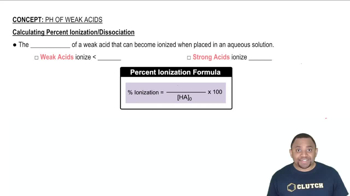A 25.0-mL sample of 0.125 M pyridine is titrated with 0.100 M HCl. Calculate the pH at each volume of added acid: 40 mL.
Consider the titration curves (labeled a and b) for two weak acids, both titrated with 0.100 M NaOH.
(i) Which acid solution is more concentrated?
 Verified step by step guidance
Verified step by step guidance
Verified Solution
Key Concepts
Titration Curves

Weak Acids and Their Concentration

Equivalence Point

A 25.0-mL sample of 0.125 M pyridine is titrated with 0.100 M HCl. Calculate the pH at each volume of added acid: 50 mL.
A 25.0-mL sample of 0.125 M pyridine is titrated with 0.100 M HCl. Calculate the pH at each volume of added acid: 0 mL, 10 mL, 20 mL, equivalence point, one-half equivalence point, 40 mL, 50 mL. Sketch the titration curve.
Consider the titration curves (labeled a and b) for two weak acids, both titrated with 0.100 M NaOH.
(ii) Which acid has the larger Ka?
Consider the titration curves (labeled a and b) for two weak bases, both titrated with 0.100 M HCl. (a)
(b)
(ii) Which base has the larger Kb?
A 0.229-g sample of an unknown monoprotic acid is titrated with 0.112 M NaOH. The resulting titration curve is shown here. Determine the molar mass and pKa of the acid.
